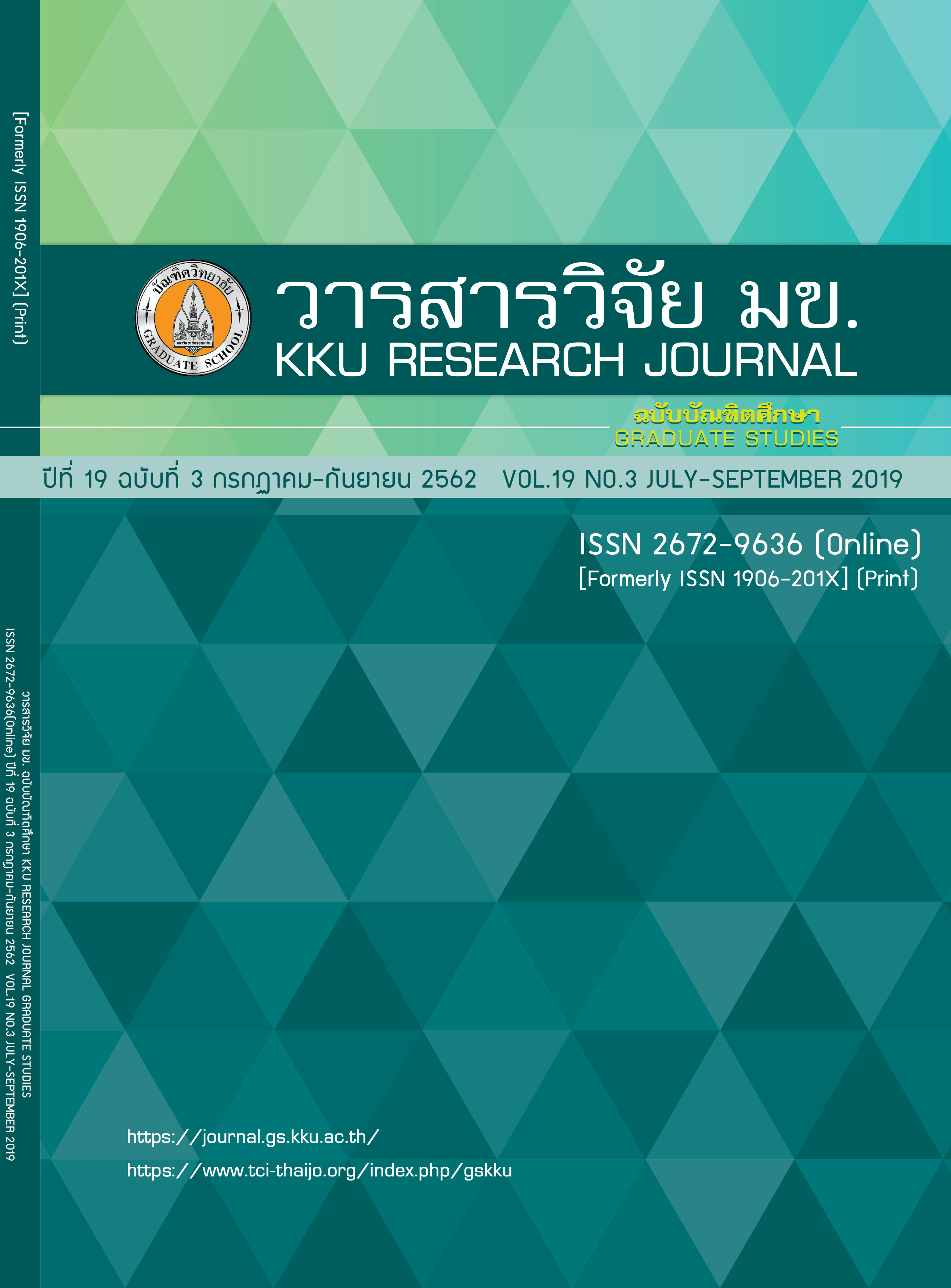Fluorescent Micellar Sensor for Long-Chain Aldehydes Detection
Keywords:
Long-chain aldehydes, Micelle, FluorescenceAbstract
Long-chain aldehyde compounds are regarded as potential biomarkers of many diseases for biomedical applications. Apart from hydrophobic tails of long-chain hydrocarbon and formyl group of long-chain aldehydes, it should perform as surfactants to form the self-assembling organized micelles. In this research, the HZ-doped micellar probes towards aldehyde have been achieved in the concept of incomplete micelle, which was prepared by CTAB and co-surfactant (S1) upon the challenge optimizing task. The micelles could form the complete micelle by long-chain aldehyde as a target analyte based on a self-assembling organized nanomicelles. The fluorescence intensity of fluorescent dye incorporated in incomplete micelle was enhanced upon the addition of long-chain aldehyde to form the complete micelles. Moreover, the fluorescence change of dye-doped micelles is proportional to the amount of long-chain aldehyde added with the limit of detection (LOD) of 80.38 µM in the linear concentration range of 0.03 to 0.33 mM in 2.5% DMSO/PBS buffer pH 7.4.
References
2. Furrukh M, Tobacco Smoking and Lung Cancer: Perception-changing facts. Sultan Qaboos University Medical Journal. 2013; 13 (3): 345-358.
3. Bumrungrad International Hospital Report of Lung Cancer [Internet] 2018 [cited 2018 June 1]. Available from: https://www.bumrungrad.com/en/pulmonary-lung-center-bangkok-thailand/conditions/lung-cancer
4. Fuchs P, Loeseken C, Schubert JK. Miekisch W. Breath gas aldehydes as biomarkers of lung cancer. International Journal of Cancer. 2010; 126 (11): 2663-2670.
5. Corradi M, Rubinstein I, Andreoli R, Manini P, Caglieri A, Poli D, Alinovi R, Mutti A. Aldehydes in exhaled breath condensate of patients with chronic obstructive pulmonary disease. American Journal of Respiratory and Critical Care Medicine. 2003; 167 (10): 1380-1386.
6. Callol-Sanchez L, Munoz-Lucas MA, Gomez-Martin O, Maldonado-Sanz JA, Civera-Tejuca C, Gutierrez-Ortega C, et al. Observation of nonanoic acid and aldehydes in exhaled breath of patients with lung cancer. Journal of Breath Research. 2017; 11 (2): 026004.
7. Ribeiro-Santos R, de Melo NR, Andrade M, Azevedo G, Machado AV, Carvalho-Costa D, et al. Whey protein active films incorporated with a blend of essential oils: Characterization and effectiveness. Packaging Technology and Science. 2017; 2352: 1-14.
8. Shahidi F, Pegg RB. Hexanal as an indicator of the flavor deterioration of meat and meat products in lipids in food flavors, American Chemical Society. 1994; 558: 256-279.
9. Li N, Deng C, Yao N, Shen X, Zhang X. Determination of acetone, hexanal and heptanal in blood samples by derivatization with pentafluorobenzyl hydroxylamine followed by headspace single-drop microextraction and gas chromatography-mass spectrometry. Analytica Chimica Acta. 2005; 540 (2): 317-323.
10. Chunhui Deng, Xiangmin Zhang, Ning Li. Investigation of volatile biomarkers in lung cancer blood using solid-phase microextraction and capillary gas chromatography–mass spectrometry. Journal of Chromatography B, 2004; 808: 269-277.
11. Liu JF, Yuan BF, Feng YQ. Determination of hexanal and heptanal in human urine using magnetic solid phase extraction coupled with in-situ derivatization by high performance liquid chromatography. Talanta. 2015; 136: 54-59.
12. Liu C, Shi C, Li H, Du W, Li Z, Wei L, Yu M. Nanomolar fluorescent quantitative detection of formaldehyde with a 8-hydroxyquinoline derivative in aqueous solution and electrospun nanofibers. Sensors and Actuators B: Chemical. 2015; 219: 185-191.
13. Tang Y, Kong X, Liu ZR, Xu A, Lin W. Lysosome-targeted turn-on fluorescent probe for endogenous formaldehyde in living cells. Analytical Chemistry. 2016; 88 (19): 9359-9363.
14. Mukherjee K, Chio TI, Gu H, Banerjee A, Sorrentino AM, Sackett DL, Bane SL. Benzocoumarin hydrazine: A large stokes shift fluorogenic sensor for detecting carbonyls in isolated biomolecules and in live cells. ACS Sensors. 2017; 2 (1): 128-134.
15. Sara M, M., M. O.; P., T. V. Applications of polymer micelles for imaging and drug delivery. Wiley Interdisciplinary Reviews: Nanomedicine and Nanobiotechnology. 2015; 7 (5): 691-707.
16. Esmaili M, Ghaffari SM, Moosavi MZ, Atri MS, Sharifizadeh A, Farhadi M, Yousefi R, Chobert JM, Haertlé T, Moosavi Movahedi AA. Beta casein-micelle as a nano vehicle for solubility enhancement of curcumin; food industry application. LWT - Food Science and Technology. 2011; 44 (10): 2166-2172.
17. Tadros TF. Future developments in cosmetic formulations. International Journal of Cosmetic Science. 1992; 14 (3): 93-111.
18. Ding L, Bai Y, Cao Y, Ren G, Blanchard GJ, Fang Y. Micelle-induced versatile sensing behavior of bispyrene-based fluorescent molecular sensor for picric acid and PYX explosives. Langmuir. 2014; 30 (26): 7645-7653.
19. Oh T, Choi JY, Heller MJ. Enhanced fluorescent resonant energy transfer of DNA conjugates complexed with surfactants and divalent metal ions. Analyst. 2016; 141 (8): 2371-2375.
20. Yan F, Su B. Tailoring Molecular Permeability of Nanochannel-Micelle Membranes for Electrochemical Analysis of Antioxidants in Fruit Juices without Sample Treatment. Analytical Chemistry. 2016; 88(22): 11001-11006.


